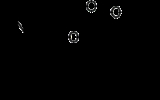
Cyclopentolate
Encyclopedia
Cyclopentolate is a mydriatic and cycloplegic
agent commonly used during pediatric eye examination
s. Cyclopentolate is also administered as an atropine
substitute to reverse muscarinic and CNS effects of indirect cholinomimetic (anti-AChase) administration.
When used in eye drops in pediatric eye examinations, Cyclopentolate 0.5% and 1.0% is used to stop the eye focusing at near distance, enabling the optometrist, ophthalmologist or orthoptist to obtain a more accurate reading of the focusing power of the eyes.
The drops take around 30 minutes to work and around 24 hours to wear off (with patients advised not to drive a vehicle or operate machinery for the first 12 hours). The pupils become wider when Cyclopentolate is administered, making the eyes more sensitive to light. Close objects (and possibly distant objects) will also appear blurred.
Side effects to Cyclopentolate are rare, but can include effects such as disorientation, incoherent speech or visual disturbances during the 24-hour period that the drug has an effect.
Cycloplegia
Cycloplegia is paralysis of the ciliary muscle of the eye, resulting in a loss of accommodation.-Anatomy:The iris is the heavily pigmented colored part of the eye. It has a contractile diaphragm in front of the lens with a central opening called the pupil...
agent commonly used during pediatric eye examination
Eye examination
An eye examination is a battery of tests performed by an ophthalmologist, optometrist, or orthoptist assessing vision and ability to focus on and discern objects, as well as other tests and examinations pertaining to the eyes....
s. Cyclopentolate is also administered as an atropine
Atropine
Atropine is a naturally occurring tropane alkaloid extracted from deadly nightshade , Jimson weed , mandrake and other plants of the family Solanaceae. It is a secondary metabolite of these plants and serves as a drug with a wide variety of effects...
substitute to reverse muscarinic and CNS effects of indirect cholinomimetic (anti-AChase) administration.
When used in eye drops in pediatric eye examinations, Cyclopentolate 0.5% and 1.0% is used to stop the eye focusing at near distance, enabling the optometrist, ophthalmologist or orthoptist to obtain a more accurate reading of the focusing power of the eyes.
The drops take around 30 minutes to work and around 24 hours to wear off (with patients advised not to drive a vehicle or operate machinery for the first 12 hours). The pupils become wider when Cyclopentolate is administered, making the eyes more sensitive to light. Close objects (and possibly distant objects) will also appear blurred.
Side effects to Cyclopentolate are rare, but can include effects such as disorientation, incoherent speech or visual disturbances during the 24-hour period that the drug has an effect.

